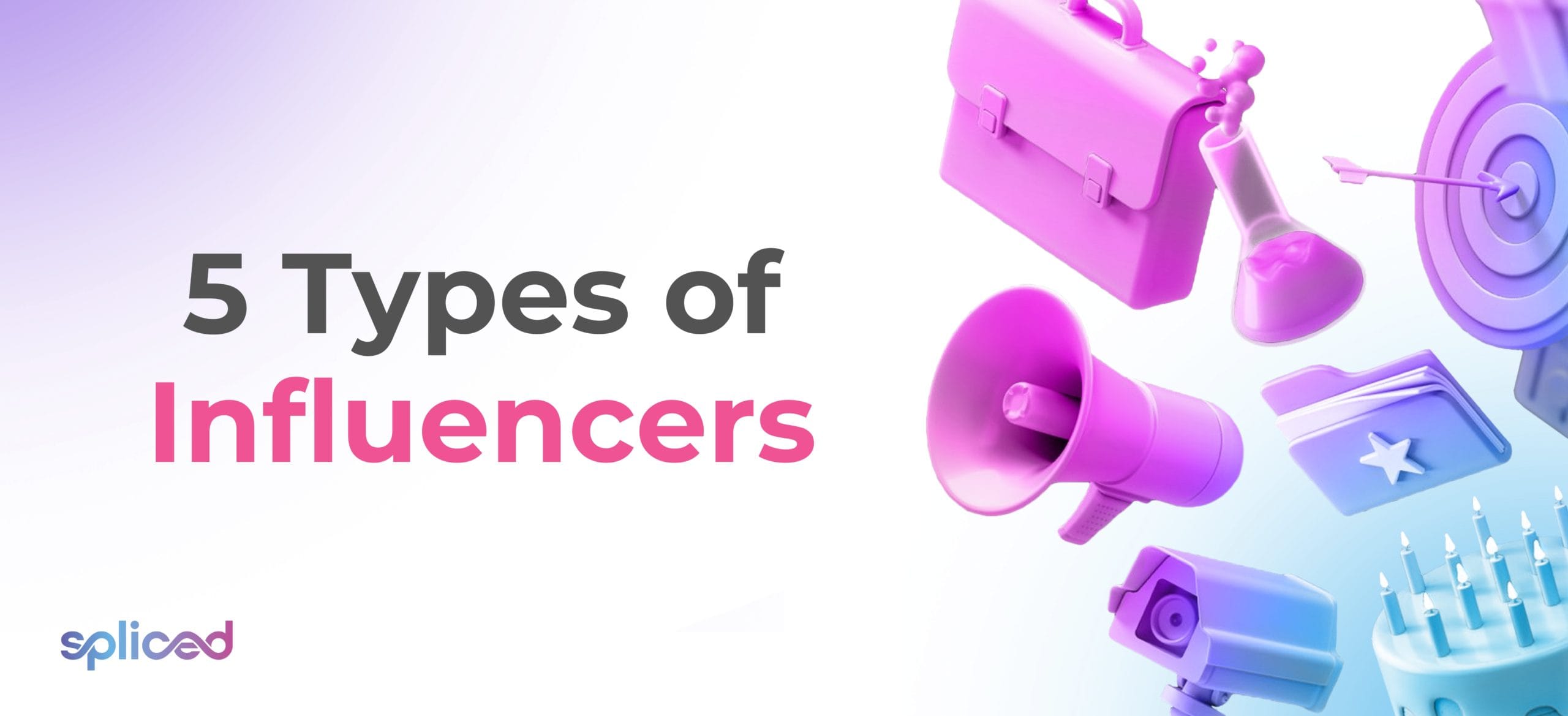Influence has expanded beyond typical celebrity endorsements, giving rise to a dynamic and diverse domain of influencer marketing. Individuals with the power to influence the purchasing choices and behaviors of a certain audience due to the experience, authority, or relatability within a given niche are referred to as influencers. Harnessing the power of these individuals through influencer marketing has become a strategic method for brands to communicate with the target consumers authentically and successfully.
Influencers’ purpose and significance come from the ability to form meaningful connections with their followers. The content frequently strikes a deeper chord with people, fostering a sense of trust that traditional advertising struggles to create. Influencers have the potential to improve brand recognition, boost product credibility, and stimulate organic interactions within their respective communities. Influencers and businesses work together to achieve exceptional results in terms of engagement and exposure.
Influencer marketing works by establishing relationships between companies and influencers. The individuals whose content aligns with a brand’s products or services are identified and collaborated with to develop real promotional material. Collaborations take many forms, including sponsored posts, product reviews, and events held by influencers. Brands use influencers’ existing rapport with their audience to build interest and demand by leveraging their influence.
The advantages of influencer marketing are numerous. It enables brands to reach highly focused consumers while improving the precision of their marketing efforts. The level of influencers adds a personal touch that appeals to the current consumer’s quest for authenticity. Influencer marketing has limitations. Finding the perfect influencers whose values and tone match the brand’s image is difficult. Keeping a balance between credibility and promotional content is critical because viewers are quick to detect fake endorsements.
Listed below are the types of influencers.
- Nano-Influencers: Nano-influencers have a small but engaged audience, but demonstrate sincerity and intimate connection with them. A strong sense of community is fostered by their content’s particular focus. Reliability benefits brands by allowing them to access a highly engaged audience and drive organic conversations about the products or services.
- Micro-Influencers: Micro-influencers have a larger following than nano-influencers, with a few thousand to tens of thousands. Micro-influencers are experts in a niche or industry that provides trusted information. The influencers foster meaningful connections and engage followers. Collaborating with micro-influencers leads to authentic endorsements and engagement, making effective brand campaign partners.
- Mid-Tier Influencers: Mid-tier influencers offer a blend of relatability and influence that reach a substantial audience while maintaining a personal connection. They cater to various audience segments and offer a balance between niche expertise and broader appeal, allowing brands to tap into their wider reach without sacrificing legitimate engagement.
- Macro-Influencers: Macro-influencers have a diverse online presence with a large audience, reaching millions through expertise, engaging content, and broader appeal. They boost brand visibility and awareness but maintain reliability while catering to a larger, diverse audience.
- Mega-Influencers: Mega-influencers are celebrities, athletes, or public figures with millions of followers. It creates instant brand recognition and exposure, driving traffic and attention. The credibility is questioned due to their large base, diluting personal connections.
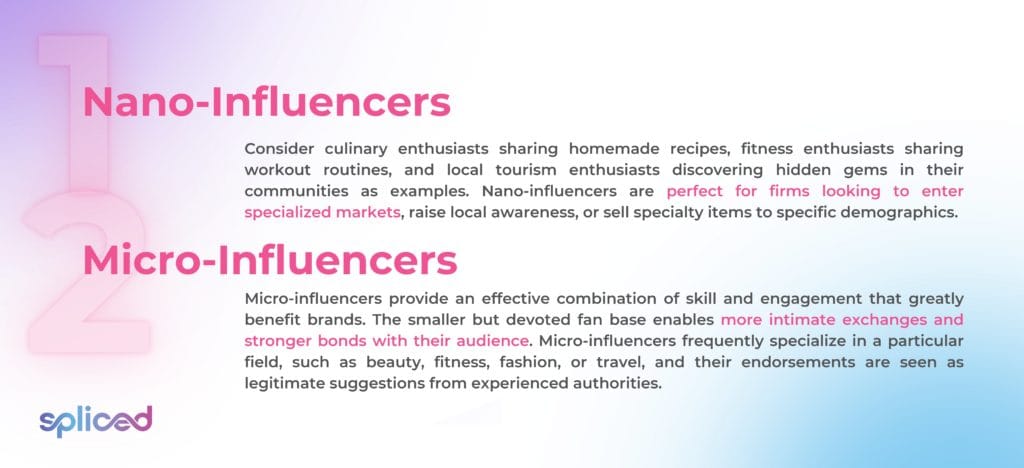
1. Nano-Influencers
Consider culinary enthusiasts sharing homemade recipes, fitness enthusiasts sharing workout routines, and local tourism enthusiasts discovering hidden gems in their communities as examples. Nano-influencers are perfect for firms looking to enter specialized markets, raise local awareness, or sell specialty items to specific demographics. Nano-influencers are a newer type of influencer and have fewer followers than micro-influencers, with fewer than 1,000 followers. Nano-influencer is someone with a small but engaged following, often ranging from a few hundred to a few thousand followers.
Nano-influencers stand out for their remarkable level of genuineness and close relationship with the audience. A strong feeling of community is fostered by nano-influencers because of their small numbers of followers, which allows them to sustain meaningful connections. Brands that collaborate with nano-influencers benefit from their authenticity, which allows them to reach a highly engaged audience and spark more organic conversations about their products or services.
Individuals who want to become nano-influencers must concentrate on creating high-quality and original content about their niche. Building a loyal community requires consistency and involvement with its audience. Working with nano-influencers is an inexpensive way to reach a highly engaged and relevant audience. Nano-influencers often charge less than larger influencers, giving them an economical alternative for brands on a tight budget. Brands look for nano-influencers by using social media platforms, hashtags, or niche-specific online groups linked to their sector.
One of the primary advantages of nano-influencers is their high level of originality and involvement. Peer endorsements are mostly seen as recommendations. The downside is that the popularity of nano-influencers is less compared to influencers with larger audiences because of their lesser number of followers. Coordinating campaigns with many nano-influencers take more time and effort. Nano-influencers frequently have higher conversion rates than larger influencers because of their close relationship with their followers. Their recommendations are considered genuine, resulting in more meaningful engagement and conversions. The engagement rates are frequently higher, which results in a more receptive audience, even though their post impressions are fewer.
2. Micro-Influencers
Micro-influencers provide an effective combination of skill and engagement that greatly benefit brands. The smaller but devoted fan base enables more intimate exchanges and stronger bonds with their audience. Micro-influencers frequently specialize in a particular field, such as beauty, fitness, fashion, or travel, and their endorsements are seen as legitimate suggestions from experienced authorities. Fitness enthusiasts share workout programs, beauty experts review skincare products, and travel enthusiasts provide detailed itineraries. Micro-influencers are perfect for brands looking to penetrate specialized markets, establish trust, and create genuine connections.
Micro-influencers are people who have created a following based on their enthusiasm, knowledge, or interest in a specific field. They continuously produce high-quality material and interact with their audience to foster a sense of community. Individuals become micro-influencers by offering valuable and niche-specific material, engaging with brands in their sector, and establishing an engaged following that respects their recommendations.
The cost of working with micro-influencers varies according to their niche, number of followers, and level of involvement. The rate is a few hundred to a few thousand dollars per post on average. Micro-influencers are found by finding relevant hashtags, examining niche-specific forums or groups, and monitoring platforms. There are advantages and disadvantages of micro-influencers. Micro-influencers have the advantage of reaching a more specific audience while maintaining a fair reach. The endorsements appear genuine and educated, resulting in better interaction rates.
The influence is limited in comparison to influencers with larger supporters. Managing a few micro-influencers for a campaign is time-consuming. Micro-influencers frequently provide great conversion rates owing to their particular expertise and genuine engagement with their followers. The posts strike a chord with their audience, resulting in meaningful conversations and a receptive audience. The content’s engagement rates are higher, even if their post impressions are smaller than those of macro-influencers.
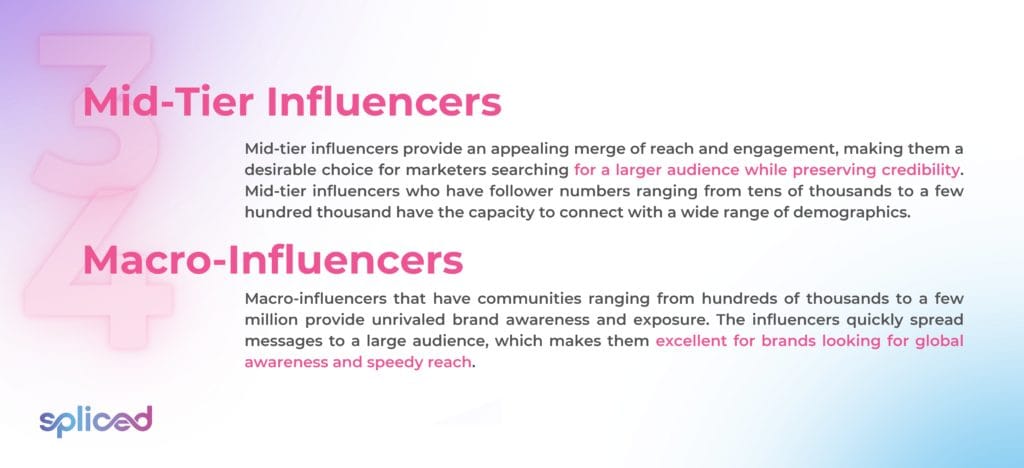
3. Mid-Tier Influencers
Mid-tier influencers provide an appealing merge of reach and engagement, making them a desirable choice for marketers searching for a larger audience while preserving credibility. Mid-tier influencers who have follower numbers ranging from tens of thousands to a few hundred thousand have the capacity to connect with a wide range of demographics. The endorsements have a level of credibility that their engaged following appreciate. Mid-tier influencers include lifestyle bloggers who share their daily lives, fitness lovers who demonstrate training regimens, and travel enthusiasts who capture their travels on camera. Mid-tier influencers boost brands because of their wider reach and ability to forge significant connections.
Individuals with a strong internet presence and frequently focusing on a certain area of interest or lifestyle, are considered mid-tier influencers. They often create material that appeals to a wide audience and connects with followers from various demographics. Individuals who want to become mid-tier influencers need to establish a distinct brand identity, keep a consistent posting schedule, communicate with their audience, and partner with brands in their field.
The cost of working with mid-tier influencers varies according to their number of followers, engagement rates, and niche expertise. They charge several hundred to a few thousand dollars per post on average. Mid-tier influencers are found by brands through social media networks, influencer marketing tools, and hashtags related to their field. Working with mid-tier influencers has the advantage of allowing businesses to reach a bigger audience while retaining personal relationships.
The endorsements attract a wide range of fans, helping to enhance brand visibility. The engagement is less passionate than that of micro-influencers, and their endorsements are less sincere. Mid-tier influencers frequently produce competitive conversion rates due to their bigger but engaged community. The material appeals to numerous audiences, resulting in meaningful conversations and potential conversions. The posts’ engagement rates are high, even if their average post impressions are smaller than those of macro-influencers.
4. Macro-Influencers
Macro-influencers that have communities ranging from hundreds of thousands to a few million provide unrivaled brand awareness and exposure. The influencers quickly spread messages to a large audience, which makes them excellent for brands looking for global awareness and speedy reach. Macro influencers often cover a wide range of topics, from fashion and beauty to lifestyle and entertainment. The endorsements generate a lot of traffic, which makes them extremely useful for product launches, big campaigns, or reaching a large audience.
Macro-influencers are famous personalities, celebrities, or public figures with a large online following. The prominence is frequently reached by a combination of experience, talent, and wider appeal. It takes achieving greatness in one’s profession, building a big following, and developing a reputation within a specific industry to become a macro-influencer.
The cost of working with macro-influencers varies on their popularity, number of followers, and level of engagement. The fees for each post run from several thousand to tens of thousands of dollars. Brands have the ability to find macro-influencers by using social media networks, and influencer marketing organizations, and by recognizing individuals who have already gained significant influence in their industry.
The main advantage of collaborating with macro-influencers is their large community and the chance for quick exposure. The endorsements have the capacity to significantly increase brand visibility and recognition. One of the disadvantages if macro-influencers are viewed as less authentic than smaller influencers, which reduces engagement and trust. A more widespread fan base means that their sponsorships are less distinctive.
The immense number of macro-influencers’ follower networks frequently results in lower engagement rates for them than for smaller influencers. The huge reach leads to considerable conversions, especially when combined with eye-catching and interesting content. The average post impressions are usually higher considering the large audience they reach.
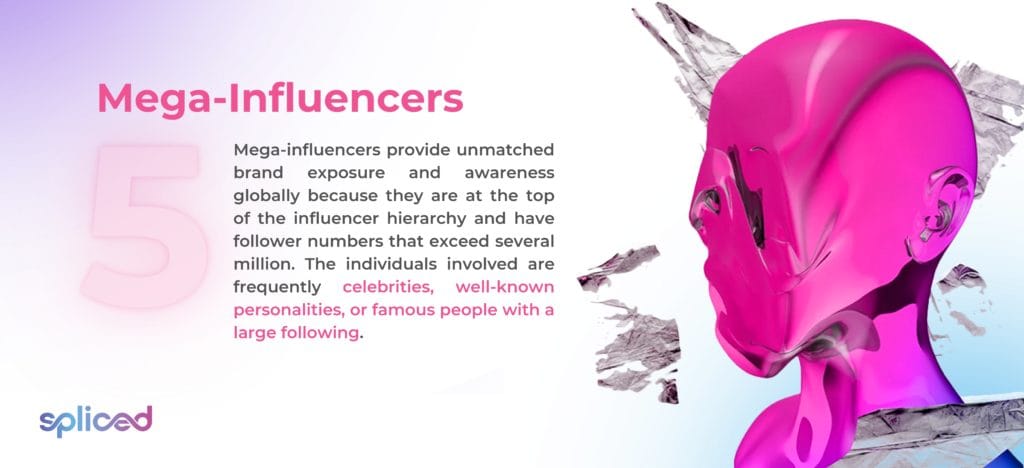
5. Mega-Influencers
Mega-influencers provide unmatched brand exposure and awareness globally because they are at the top of the influencer hierarchy and have follower numbers that exceed several million. The individuals involved are frequently celebrities, well-known personalities, or famous people with a large following. The endorsements of mega-influencers generate quick brand recognition that makes them ideal for huge promotional events, high-profile product launches, or campaigns aimed at a large audience across multiple demographics.
Mega-influencers are people who have earned considerable popularity and fame, within the boundaries of social media. The people involved are celebrities, actors, musicians, or industry pioneers who have established a sizable fan base as a result of their accomplishments and fame. Becoming a mega-influencer entails excelling in a specific profession and achieving a level of celebrity that exceeds traditional influencer rank.
Working with mega-influencers is significantly more expensive than working with other influencer levels because of their famous status and massive reach. The costs for each post rise from tens of thousands to hundreds of thousands of dollars. Mega-influencers are found by brands through influencer marketing companies, industry events, or by finding individuals who have acquired great global popularity.
Working with mega-influencers has the primary advantage of generating quick brand recognition and visibility. The endorsements result in tremendous engagement and awareness, particularly when targeting a broad and varied audience. Mega-influencers’ endorsements come out as less genuine due to their enhanced status, which has an impact on the amount of trust and engagement. The endorsements lack the customized touch that lesser influencers provide. Mega-influencers frequently have lower engagement rates than smaller followers. The endorsements bring substantial visitors and conversions, particularly for firms wanting a global reputation. The average post impressions are higher.
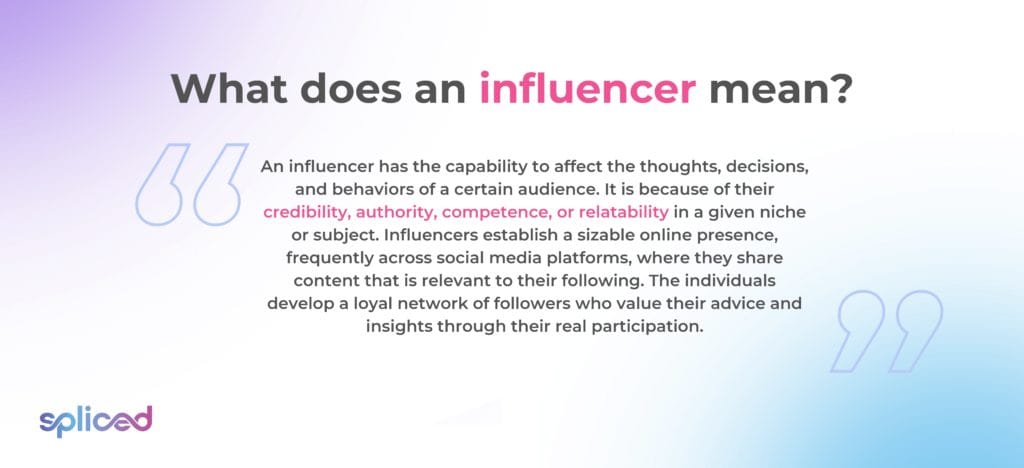
What does “Influencer” mean?
An influencer has the capability to affect the thoughts, decisions, and behaviors of a certain audience. It is because of their credibility, authority, competence, or relatability in a given niche or subject. Influencers establish a sizable online presence, frequently across social media platforms, where they share content that is relevant to their following. The individuals develop a loyal network of followers who value their advice and insights through their real participation.
Influencers are classified into several categories, ranging from micro-influencers with small but engaged audiences to mega-influencers with gigantic follower numbers. The capacity to influence customer perceptions and purchase decisions has led to the growth of influencer marketing, in which corporations work with influencers to promote products, services, or campaigns to their dedicated audience authentically and engagingly.
An influencer is someone who promotes products to their followers on social media platforms such as Instagram, Facebook, and TikTok. Influencer translates to other sites, such as Twitter and, more recently, LinkedIn. The ability to make engaging material shows what is an influencer that sets great apart from average ones. Great influencers produce unique photographs, descriptions, films, and blogs that showcase a company in its best light, yet remain genuine to themselves and their fans.
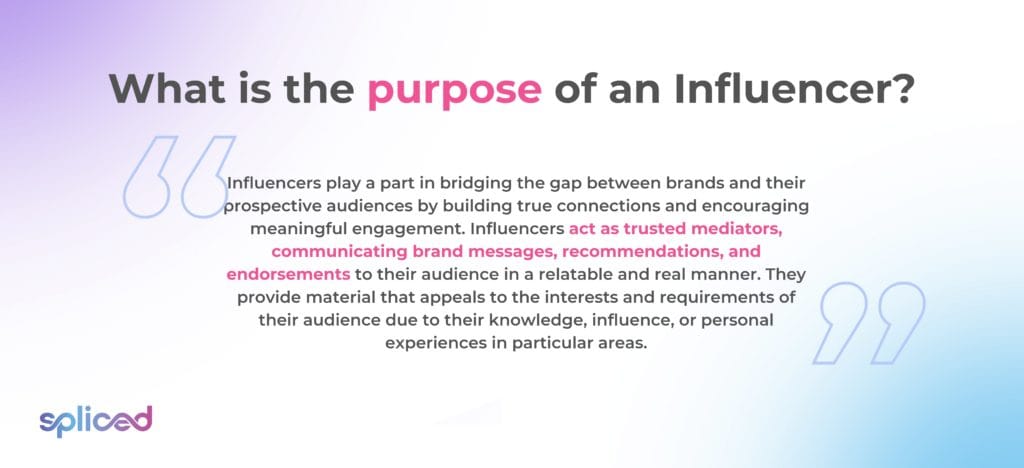
What is the purpose of an Influencer?
Influencers play a part in bridging the gap between brands and their prospective audiences by building true connections and encouraging meaningful engagement. Influencers act as trusted mediators, communicating brand messages, recommendations, and endorsements to their audience in a relatable and real manner. They provide material that appeals to the interests and requirements of their audience due to their knowledge, influence, or personal experiences in particular areas. Influencers develop a unique level of trust with their followers through relatability and authenticity, leading to higher levels of engagement and a readiness to heed their advice.
Influencers use multiple venues such as social media, blogs, and video content to share product or service insights, reviews, tutorials, and personal experiences. The tailored approach enables people to demonstrate how a specific brand or product fits their lifestyle, needs, and preferences. Influencers improve brand awareness, reputation, and meaningful connections, which makes them valuable in modern marketing methods.
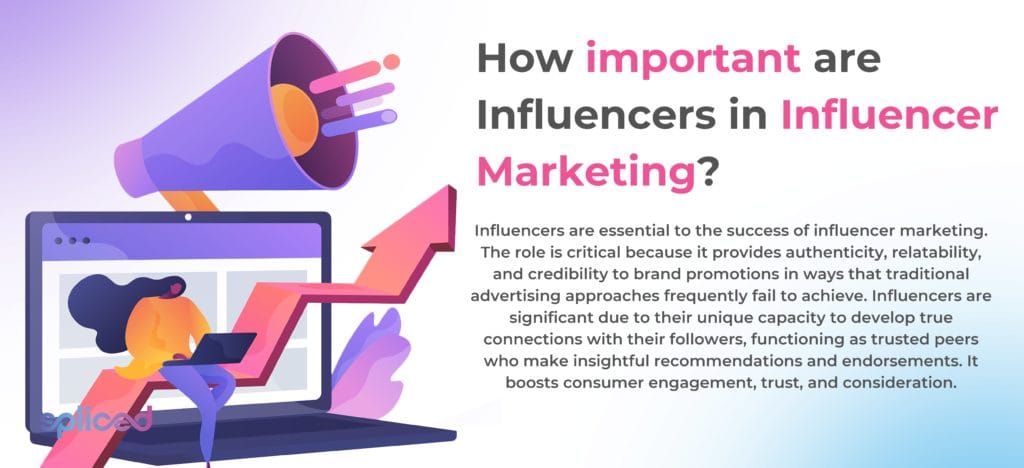
How important are Influencers in Influencer Marketing?
Influencers are essential to the success of influencer marketing. The role is critical because it provides authenticity, relatability, and credibility to brand promotions in ways that traditional advertising approaches frequently fail to achieve. Influencers are significant due to their unique capacity to develop true connections with their followers, functioning as trusted peers who make insightful recommendations and endorsements. It boosts consumer engagement, trust, and consideration. Collaboration with other influencers allows organizations to effectively target certain demographics, access specialized markets, and generate bespoke, unique content that resonates with their intended audience.
Influencers have a deep awareness of the platforms on which they operate, whether they are social media platforms, such as Instagram or YouTube, or developing platforms like TikTok. The ability to create content that resonates with their audience’s interests and behaviors guarantees that the brand’s message is presented in a way that not attracts attention but maximizes engagement. Influencer marketing effectively humanizes the marketing process, transforming it into a conversation between a trusted friend and the audience, which has the potential to increase conversion rates.
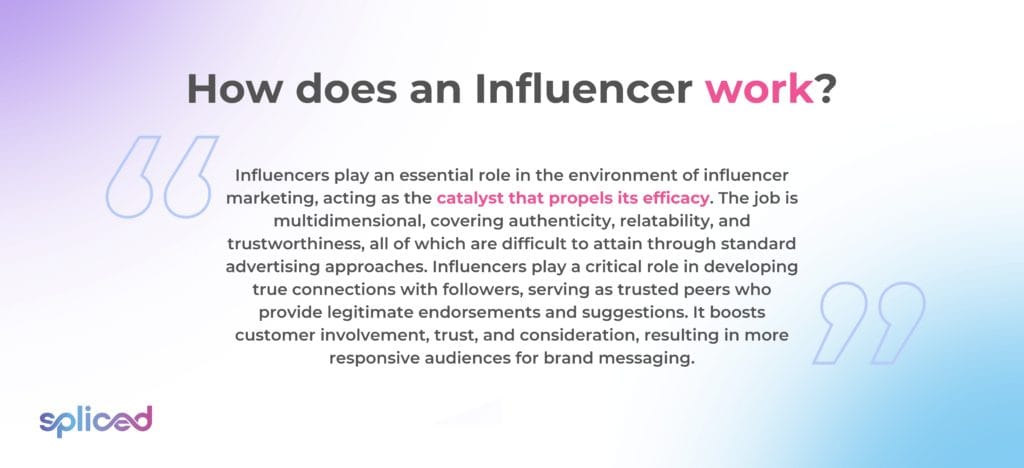
How does an Influencer work?
Influencers play an essential role in the environment of influencer marketing, acting as the catalyst that propels its efficacy. The job is multidimensional, covering authenticity, relatability, and trustworthiness, all of which are difficult to attain through standard advertising approaches. Influencers play a critical role in developing true connections with followers, serving as trusted peers who provide legitimate endorsements and suggestions. It boosts customer involvement, trust, and consideration, resulting in more responsive audiences for brand messaging.
Collaboration with influencers allows brands to precisely target certain demographics, enter specialized markets, and curate content that authentically resonates with the targeted audience. Influencers work with brands to promote their products, services, or campaigns to their audiences. Brands find influencers whose following is similar to their target demographic and then suggest collaborations in which the influencer organically incorporates the brand’s offers into their content. The seamless integration guarantees that the brand’s message is delivered genuinely and engagingly to the influencer’s audience.
Influencers are valuable because of their keen understanding of platform dynamics, whether on established social media platforms, such as Instagram and YouTube, or in new places like TikTok. The ability to create content that aligns with the preferences and behaviors of their target audience ensures that brand messages are presented in formats that command attention and drive meaningful connections. Influencers essentially humanize the marketing process, turning it into a genuine conversation between a trusted confidant and the audience, which greatly increases conversion rates.
Influencers utilize their trustworthiness and relatability to communicate commercials that resonate with the supporters. The effectiveness comes from their ability to establish genuine connections, which leads to increasing engagement and conversions.
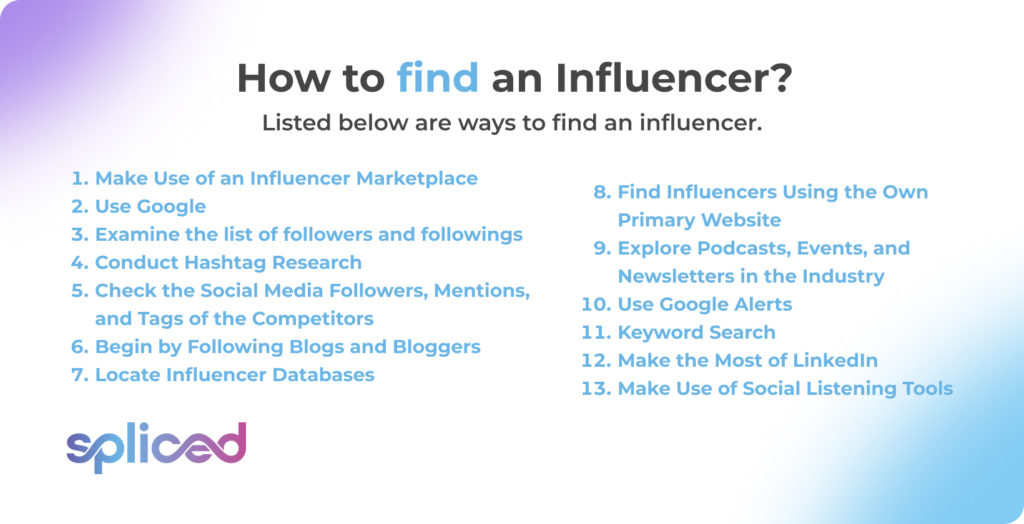
How to find an Influencer?
Listed below are ways to find an influencer.
- Make Use of an Influencer Marketplace: The market’s quick evolution is one of the best aspects of influencer marketing. Businesses now quickly locate influencers and interact with them due to several influencer locator tools.
- Use Google: Find using Google social media influencers who have the ability to help increase of brand awareness and reach the target audience. Searching for the proper influencers takes significantly more time and energy because of manual searches and audits to check out their online activities. It is significant for not wasting money on a bogus source or unrelated influencers for the business and campaign.
- Examine the list of followers and followings: An individual locates influencers to work with among the people who are already interested in what it is by checking the followers’ list.
- Conduct Hashtag Research: Doing hashtag research is one of the most popular techniques to locate influencers to work with. Twitter and Instagram are the two finest venues to use because Twitter and Instagram influencers are known for their interest in hashtags and following trends.
- Check the Social Media Followers, Mentions, and Tags of the Competitors: Locate a decent vantage point from which to observe what the rivals are doing on social media posts.
- Begin by Following Blogs and Bloggers: Another effective strategy is to subscribe to relevant blogs. Following blogs help to figure out who the industry’s leaders and opinion shapers are. It allows businesses to determine which individuals have a sizable social media presence and are inclined to be influencers or brand ambassadors promoting the company.
- Locate Influencer Databases: The databases provide a broader range of influencers than a list of open hashtags, and assist businesses in managing relationships with influencers and running campaigns.
- Find Influencers Using the Own Primary Website: The business website must include a link in the footer that allows influencers and brand ambassadors to contact the company and contact information for potential affiliates.
- Explore Podcasts, Events, and Newsletters in the Industry: There are plenty of online sites that help to locate influencers, such as podcasts, events, and newsletters. They are useful in determining who is being talked about the most and who has the most influence in the industry.
- Use Google Alerts: Utilize Google Alerts to identify influencers associated with the products or company.
- Keyword Search: Searching for the top videos and channels in the area of interest on Google and other platforms using post keywords helps to uncover established social media influencers.
- Make the Most of LinkedIn: LinkedIn is a powerful networking platform that is used for more than simply keeping in touch with coworkers. The ability to look for influencers on LinkedIn appears unusual.
- Make Use of Social Listening Tools: Platforms for social media monitoring and listening, such as Hootsuite and Mention, are excellent on how to find influencers. The tools help to find individuals who are talking about the company, and people who have already shared the content because they are interested in the brand or products.
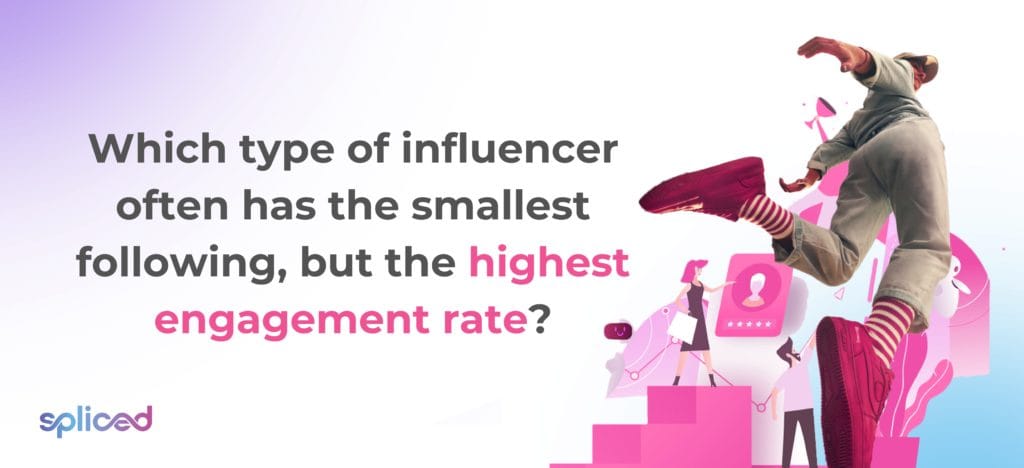
Which type of influencer often has the smallest following, but the highest engagement rate?
Micro-influencers are known for having the smallest following, but they have the greatest engagement rates of any influencer category. Micro-influencers develop a loyal and engaged audience within a small specialty, with follower counts often ranging from a few thousand to tens of thousands. The honest and relatable material strikes a deep chord with their audience, building genuine connections that lead to increased levels of involvement, likes, comments, and shares. Micro-influencers frequently have astonishingly high engagement rates when compared to influencers with bigger followings, owing to their particular expertise and personal interaction with their audience. Brands looking for honest and meaningful connections profit from collaborating with micro-influencers to reach their loyal and receptive audience.
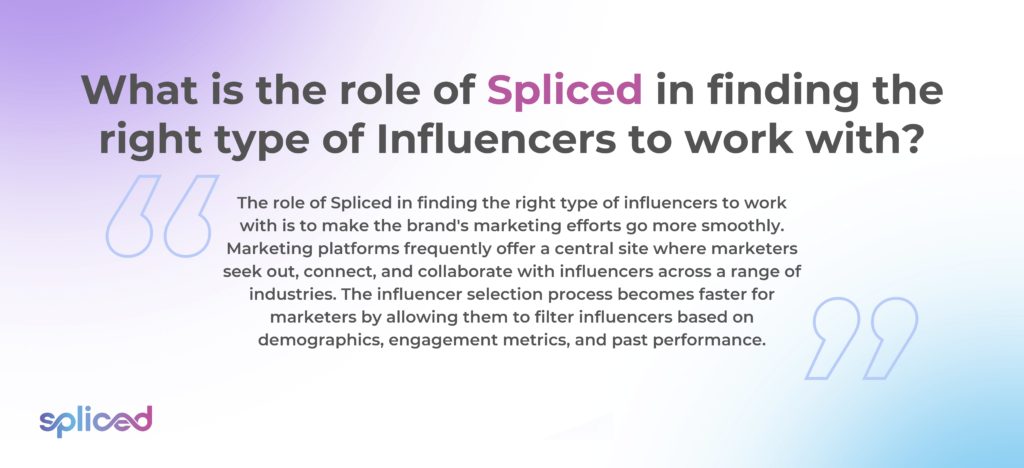
What is the role of Spliced in finding the right type of Influencers to work with?
The role of Spliced in finding the right type of influencers to work with is to make the brand’s marketing efforts go more smoothly. Marketing platforms frequently offer a central site where marketers seek out, connect, and collaborate with influencers across a range of industries. The influencer selection process becomes faster for marketers by allowing them to filter influencers based on demographics, engagement metrics, and past performance.
Spliced assesses an influencer’s reach, demographics, and engagement rates using data analytics. It facilitates the search for influencers with a fan base that resembles that of their intended audience. Spliced allows marketers to evaluate the success of past initiatives by providing details about an influencer’s previous collaborations. Spliced is essential for choosing the finest live influencer because it boosts productivity, provides data-driven tools for decision-making, and facilitates easy collaboration between influencers and businesses. The effectiveness of influencer marketing efforts is affected by a majority of elements.
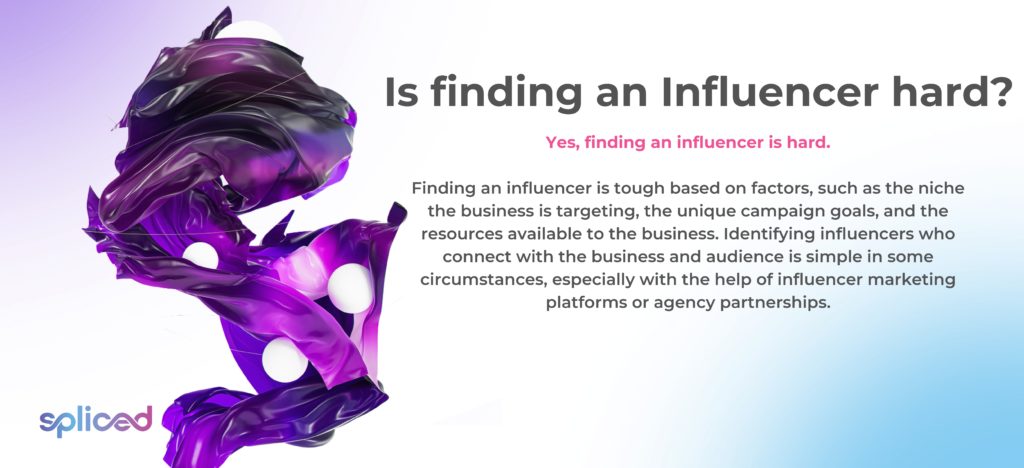
Is finding an Influencer hard?
Yes, finding an influencer is hard. Finding an influencer is tough based on factors, such as the niche the business is targeting, the unique campaign goals, and the resources available to the business. Identifying influencers who connect with the business and audience is simple in some circumstances, especially with the help of influencer marketing platforms or agency partnerships. The platforms make the search process easier by giving users access to a database of potential influencers.
Finding the ideal influencer is highly specialized or competitive. It necessitates a more thorough investigation and careful analysis to ensure authenticity and fit. A successful influencer marketing strategy depends on investing time in selecting an influencer that shares the same values as the business and has a strong rapport with the target audience, despite potential difficulties with authenticity assessment, engagement evaluation, and negotiation.

Is finding an Influencer expensive?
Yes, finding an influencer is expensive. The cost of hiring an influencer varies greatly depending on the technique businesses adopt and the available resources. The use of influencer marketing platforms and agencies incurs fees because they simplify the process by connecting with influencers who align with the brand. The services incur additional charges, even if they help speed up the search. Manual research and outreach are time-consuming but perhaps more cost-effective in terms of direct expenses.
The true expenses of finding an influencer lie in the meticulous assessment of potential influencers to ensure they genuinely reproduce with the brand’s values, target audience, and campaign goals. Finding an influencer is not expensive in terms of monetary outlay. Securing a genuine and successful collaboration that produces the intended results for the influencer marketing strategy requires a commitment, whether it is time or money.
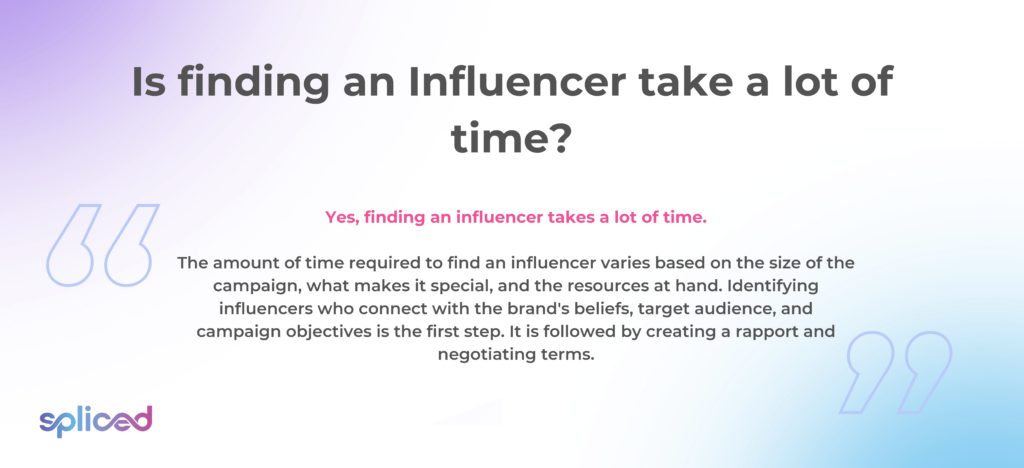
Is finding an influencer take a lot of time?
Yes, finding an influencer takes a lot of time. The amount of time required to find an influencer varies based on the size of the campaign, what makes it special, and the resources at hand. Identifying influencers who connect with the brand’s beliefs, target audience, and campaign objectives is the first step. It is followed by creating a rapport and negotiating terms. Considerable research is often necessary to establish a compatible fit while certain influencers are found quickly, especially with the support of influencer marketing platforms or agency partnerships.
The time spent ranges from a few hours to several days depending on criteria, such as the influencer’s legitimacy, engagement rates, and the complexities of their content. It is necessary to devote time to choosing the perfect influencer to guarantee smooth cooperation that resonates with the target audience and efficiently fulfills the campaign goals.
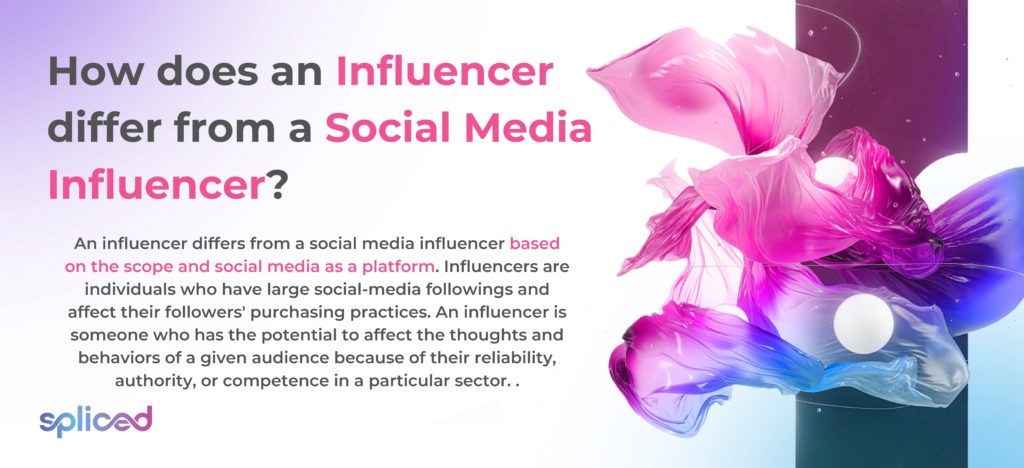
How does an Influencer differ from a Social Media Influencer?
An influencer differs from a social media influencer based on the scope and social media as a platform. Influencers are individuals who have large social-media followings and affect their followers’ purchasing practices. An influencer is someone who has the potential to affect the thoughts and behaviors of a given audience because of their reliability, authority, or competence in a particular sector. The power extends beyond social media platforms and into other contexts, including industry expertise, public speaking, or professional reputation.
A social media influencer is someone who exerts power and influence through online platforms. Social media influencers are using platforms, such as Instagram, YouTube, TikTok, Twitter, and others. The influencers use the platforms to establish loyal supporters and communicate with their followers through posts, stories, videos, and connections. They frequently post about that subject on their preferred social media platforms, where they develop large communities of devoted followers who closely follow their opinions. It is a way to effectively bridge the gap between brands and consumers by using their platforms to share personal knowledge, insights, and recommendations.
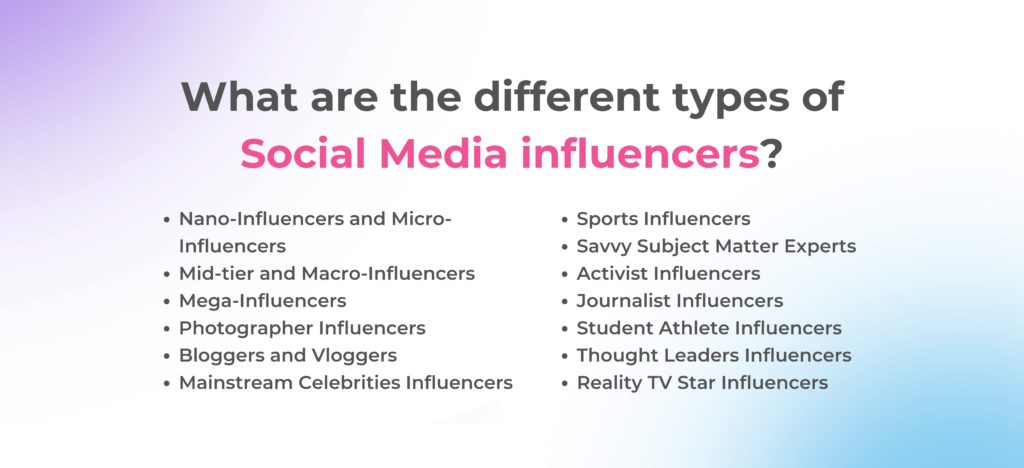
Are there other types of Social Media influencers?
Listed below are different types of social media influencers.
- Nano-Influencers and Micro-Infulencers: The number of followers distinguishes the type of influencers, nano-influencers have less than 10,000 followers. Micro-influencers have around 10,000 to 50,000 followers. They publish regular material earn money from brand relationships and generally work part-time to create and monetize content. Micro-influencers are referred to as the “influencer triple threat” due to their devoted fan bases and specialized interests.
- Mid-tier and Macro-Influencers: Mid-tier influencers have between 25,000 and 100,000 followers, while macro-influencers have between 100,000 and 500,000 followers. Each type of influencer works full-time and commonly includes journalists, bloggers, and YouTubers. Macro influencers have a small crew, but they are in charge.
- Mega-Influencers: Mega-influencers have more than 500,000 followers and are popular on social media, but their costs and competition are huge. They do not apply to brand campaigns and are typically obtained from brands offering them.
- Photographer Influencers: Social media has benefited photographers. Some photographers achieved celebrity and influencer status through platforms, such as Instagram, rather than through works that were released.
- Bloggers and Vloggers: Bloggers and video bloggers were the first individuals to leverage the written word and YouTube to demonstrate their expertise in generating long-lasting content and incorporating their skills into a digital activity.
- Mainstream Celebrities Influencers: Celebrity influencers typically have tens of thousands, if not millions, of followers, classifying as macro- or mega-influencers. These content makers generally charge an extra fee for their work.
- Sports Influencers: Sports influences range from high school athletes to university athletes, pros to announcers, and coaches to superfans. Sports influencers have a wide range of abilities and skills, but the college athlete is the most common content creator in the space.
- Savvy Subject Matter Experts: SME bloggers and vloggers have demonstrated expertise and their work must be acknowledged. Consumers trust creators who make verified claims and viewers reject sponsored content that fails to do the same.
- Activist Influencers: Activist influencers are creators who utilize social media to reach out to audiences and oppose injustice. The purpose is not to gain fame but to bring attention to groups that are neglected. They keep up with trends and network with the public via direct messaging.
- Journalist Influencers: Journalists are classified as macro-influencers due to their knowledge and exposure to audiences outside social media.
- Student Athlete Influencers: Influencers who are student-athletes already work with a variety of brands beyond the sports industry. The NIL train has stepped on to activate well-known producers in apparel, food and beverage, gaming, gambling, electronics, and other industries.
- Thought Leaders Influencers: Popular social media thought leaders take numerous shapes, especially in the influencer era. Executives are frequently active on at least one social media channel, including Twitter or LinkedIn, creating content that offers insight and enthusiasm to followers.
- Reality TV Star Influencers: Reality television has given birth to numerous social media celebrities who create a fortune producing sponsored content. Certain influencers appear on television to gain more publicity for their brands. Popularity and recognition are not necessarily negative traits, especially when brands are willing to collaborate with creators whose sole claim to fame is appearing on television.
Companies must examine a few factors to know what is the most effective social media for influencer marketing before hiring them. The types of social media influencers have their characteristics and skills.
